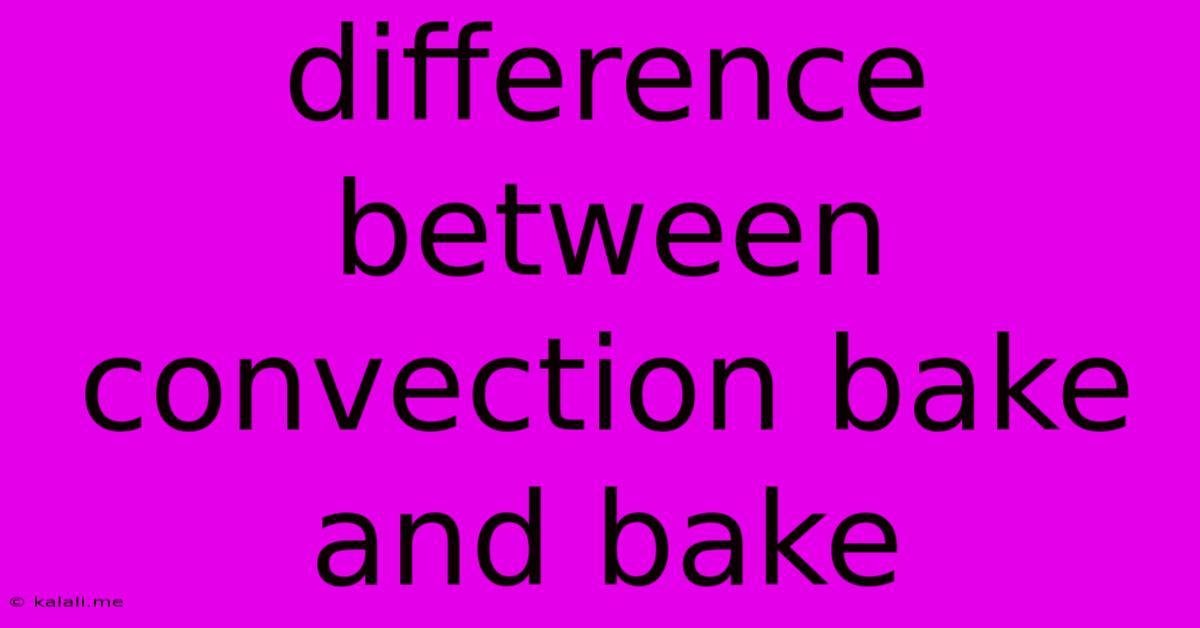Difference Between Convection Bake And Bake
Kalali
May 24, 2025 · 3 min read

Table of Contents
Convection Bake vs. Bake: Understanding the Difference for Perfect Baking Results
Choosing between convection bake and bake settings on your oven can significantly impact the outcome of your baked goods. Understanding the difference between these two methods is key to achieving perfectly baked cakes, cookies, breads, and more. This article will clarify the distinctions, highlighting when to use each setting for optimal results.
What is Bake?
The standard "bake" setting utilizes radiant heat from the oven's bottom and top elements. Heat circulates naturally through the oven cavity via convection currents – but these are relatively slow and less efficient than forced convection. This method is ideal for many recipes, particularly those that require even browning and a slower cooking process. However, it can lead to uneven cooking, especially in larger ovens or with dense baked goods.
What is Convection Bake?
Convection bake utilizes a fan to circulate hot air throughout the oven. This forced convection ensures more even heat distribution, resulting in faster cooking times and more consistent browning. The fan speeds up the heat transfer process, reducing hot and cold spots within the oven cavity. This is especially beneficial for baking multiple items simultaneously or for recipes requiring crispiness.
Key Differences Summarized:
| Feature | Bake | Convection Bake |
|---|---|---|
| Heat Source | Radiant heat (top & bottom) | Radiant heat + fan-circulated air |
| Heat Distribution | Uneven, can have hot spots | Even, consistent heat |
| Cooking Time | Longer | Shorter |
| Browning | Can be uneven | More even and often crispier |
| Energy Efficiency | Less efficient | More efficient |
When to Use Each Setting:
-
Bake:
- Cakes: Delicate cakes benefit from the gentler heat of a standard bake setting. The slower cooking process allows for even rising.
- Yeast breads: The slower heating prevents the yeast from being shocked and promotes a better rise.
- Dishes requiring delicate browning: If even browning is crucial but not necessarily crispy, the traditional bake might be better.
-
Convection Bake:
- Cookies: Convection bake helps achieve crispy edges and evenly baked cookies, particularly when baking multiple sheets at once.
- Roasted vegetables: Faster cooking times and even browning are ideal for roasting vegetables, maximizing their flavor and texture.
- Pies and pastries: For a flaky crust and evenly baked filling, convection bake excels.
- Multiple dishes simultaneously: Baking multiple items at once is more efficient and results in better consistency with convection.
- Recipes that call for it specifically: Always follow the instructions in your recipe. Many modern recipes are designed with convection in mind.
Important Considerations:
- Temperature Adjustments: When using convection bake, you may need to reduce the oven temperature by 25°F (14°C) compared to a standard bake recipe. This is because the forced air circulates heat more efficiently.
- Oven Variations: Oven performance varies greatly between brands and models. Experimentation is key to finding the optimal settings for your specific oven.
- Recipe Accuracy: Always follow the recipe instructions. If a recipe specifies a particular baking method, it's best to follow that recommendation.
By understanding the differences between convection bake and bake, you can elevate your baking skills and achieve consistently delicious results. Experiment with both methods and discover which settings best suit your baking needs and your oven. Happy baking!
Latest Posts
Latest Posts
-
Convert Quick Release To Thru Axle
May 24, 2025
-
Well Butter My Butt And Call Me A Biscuit
May 24, 2025
-
Can A Sentence End With Is
May 24, 2025
-
How To Replace Stem On Bathtub Faucet
May 24, 2025
-
How Long Do Pb And J Sandwiches Last
May 24, 2025
Related Post
Thank you for visiting our website which covers about Difference Between Convection Bake And Bake . We hope the information provided has been useful to you. Feel free to contact us if you have any questions or need further assistance. See you next time and don't miss to bookmark.